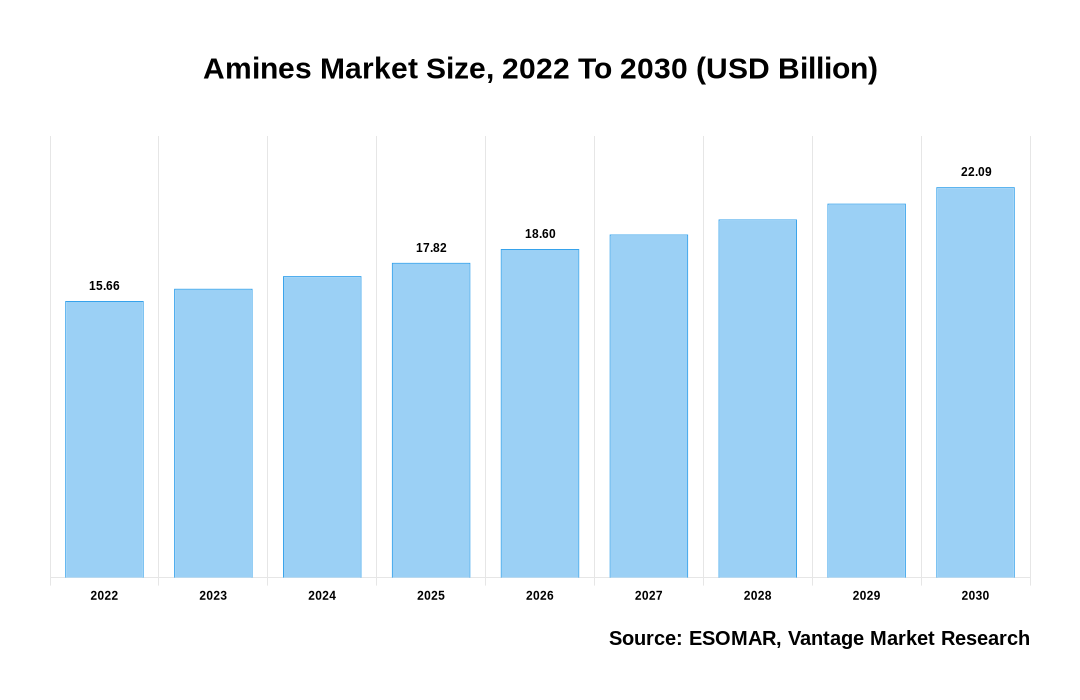Global Amines Market
As stated in our extensive report; the Global Amines Market accounted for USD 15.2 Billion in the year 2021.
The need for personal care products has increased, fueling the expansion of this market. This demand is driven by the growing population, rising disposable income, and expanding consumer health and hygiene awareness. The development of the Amines sector has been aided by the expanding need for crop protection and pesticides, particularly in emerging nations. Amines are being used more frequently in paints, coatings, and the building industry, fostering the expansion of this market.
The market for Amines has grown mainly due to expanding uses in water treatment and surfactant use. In the upcoming years, the worldwide Amines industry is anticipated to experience major growth prospects due to factors including rising demand from emerging nations, the creation of new applications, and technological advancements. Due to the increasing end-user sector demand for Amines as a raw material in the manufacture of azo dyes and as an ingredient for making medications in the pharmaceutical industry, India and China are predicted to function as major countries to drive the expansion.

Click To Get a Free Sample On the Research Study
Factors Influencing Global Amines Market Growth
The growth of the global Amines market can be attributable to the following:
- Growing application potential in personal care products, crop protection, paint & coatings, surfactants, and water treatment are the main drivers of the Amines market’s anticipated significant rise throughout the projection period.
- Over the next eight years, fertilizer consumption in agriculture is expected to expand along with farmers’ increasing desire for yield improvement.
- There are expected to be attractive market prospects due to the growth of the personal care sector, where Amines are used to make cosmetics, toiletries, skincare, hair care, and fragrances.
- The need for gas treatment by Amines to remove carbon dioxide (CO2) and hydrogen sulfide (H2S) from refinery process streams is predicted to expand in the future.
- The textile industry’s need for Amines is projected to increase as their use in the production of inks and dyes grows. Additionally, the growing interest in cleanliness and personal hygiene will increase demand for amine-containing detergents and fabric softeners.
- For the projection period, it is expected that increasing demand for heavy-duty laundry detergents and improving infrastructural expansion in the BRICS countries will drive market demand.
- The market for Amines is predicted to have tremendous development potential due to the pharmaceutical industry’s increasing demand for Amines to produce painkillers.
On the other hand, obstacles that can impede the market expansion of Amines include fluctuating raw material costs and adverse environmental impacts.
Asia Pacific Region to Take Over the Market
Asia Pacific holds the most significant share in the Amines market and is anticipated to continue this trend during the forecast period. This is due to many factors, including expanding economic development, increasing R&D efforts to produce high-quality Amines and rising demand for agriculture. Additionally, the increasing need for various Amines, such as diethanolAmines, which are utilized to make glyphosate, a substance that enhances the effectiveness of herbicides, is anticipated to support market expansion in the area. The region’s market share is expected to be dominated by China, India, Malaysia, and Indonesia, mainly due to expanding government programs for sustainable development.
Conclusion
The overall Amines market sales have been positively impacted by the rising demand for crop protection chemicals, rising need for personal care products, and rising demand for surfactants.
The well-known players of the Global Amines Market include Arkema SA (France), Akzo Nobel N.V. (Netherlands), BASF SE (Germany), SABIC (Saudi Arab), The Dow Chemical Company (US), Huntsman Corporation (US), Mitsubishi Gas Chemical Company (Japan) and others.
![[Market Research Reports] – Research Google News Blog | VMR.Biz](https://www.vmr.biz/wp-content/uploads/2022/12/logo-removebg-preview.png)











